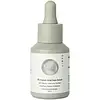What's inside
What's inside
 Key Ingredients
Key Ingredients

 Benefits
Benefits

 Concerns
Concerns

 Ingredients Side-by-side
Ingredients Side-by-side

Water
Skin ConditioningPropanediol
SolventAzelaic Acid
Buffering1,2-Hexanediol
Skin ConditioningEthoxydiglycol
HumectantGlycerin
HumectantSodium Hydroxide
BufferingSalicylic Acid
MaskingMandelic Acid
AntimicrobialBifida Ferment Lysate
Skin ConditioningCapryloyl Glycine
CleansingSarcosine
Skin ConditioningCinnamomum Zeylanicum Bark Extract
AntimicrobialCamellia Sinensis Leaf Extract
AntimicrobialPotassium Sorbate
PreservativeSodium Benzoate
MaskingGluconolactone
Skin ConditioningBetaine
HumectantInulin
Skin ConditioningSodium Hyaluronate
HumectantWater, Propanediol, Azelaic Acid, 1,2-Hexanediol, Ethoxydiglycol, Glycerin, Sodium Hydroxide, Salicylic Acid, Mandelic Acid, Bifida Ferment Lysate, Capryloyl Glycine, Sarcosine, Cinnamomum Zeylanicum Bark Extract, Camellia Sinensis Leaf Extract, Potassium Sorbate, Sodium Benzoate, Gluconolactone, Betaine, Inulin, Sodium Hyaluronate
Water
Skin ConditioningPolyglycerin-6
HumectantAzelaic Acid
BufferingBetaine
HumectantHydroxyethyl Acrylate/Sodium Acryloyldimethyl Taurate Copolymer
Emulsion StabilisingPropylene Glycol
HumectantEthoxydiglycol
HumectantSalicylic Acid
MaskingGlycolic Acid
BufferingChondrus Crispus Extract
Skin ConditioningCitric Acid
BufferingNiacinamide
SmoothingPanthenol
Skin ConditioningPhenoxyethanol
PreservativeEthylhexylglycerin
Skin ConditioningOctenidine Hcl
AntimicrobialPolyacrylate Crosspolymer-6
Emulsion StabilisingPhytic Acid
Triethanolamine
BufferingWater, Polyglycerin-6, Azelaic Acid, Betaine, Hydroxyethyl Acrylate/Sodium Acryloyldimethyl Taurate Copolymer, Propylene Glycol, Ethoxydiglycol, Salicylic Acid, Glycolic Acid, Chondrus Crispus Extract, Citric Acid, Niacinamide, Panthenol, Phenoxyethanol, Ethylhexylglycerin, Octenidine Hcl, Polyacrylate Crosspolymer-6, Phytic Acid, Triethanolamine
Ingredients Explained
These ingredients are found in both products.
Ingredients higher up in an ingredient list are typically present in a larger amount.
Azelaic acid is a multitasker ingredient that helps treat acne, pigmentation, and irritation. It is a great option for sensitive skin.
What makes azelaic special?
The best thing about azelaic acid is it's gentleness. It's generally well-tolerated and safe to use alongside other actives like niacinamide or salicylic acid.
Unlike AHAs, azelaic acid will not make you photosensitive/sun sensitive.
You can find this ingredient naturally occurring in grains like wheat, rye, and barley. In cosmetics, azelaic acid is typically lab-made, which is more stable and effective.
Learn more about Azelaic AcidBetaine is a common humectant (a substance that promotes retention of moisture). It's known to be gentle on the skin and can help balance hydration.
This ingredient is best for improving hydration and soothing irritated skin. Studies also show it helps even out skin tone.
Fun fact: Betaine is naturally created in the skin and body. The kind found within cosmetic products can be either plant-derived or synthetic.
Another name for betaine is trimethylglycine.
Learn more about BetaineEthoxydiglycol is a synthetic solvent.
Solvents are used to keep ingredients together in a product. They can help dissolve ingredients to stable bases or help evenly distribute ingredients throughout the product.
Ethoxydiglycol also helps deliver other key ingredients into the skin.
Learn more about EthoxydiglycolSalicylic Acid (also known as beta hydroxy acid or BHA) is a well-known ingredient for treating skin that struggles with acne and clogged pores. It exfoliates both the skin's surface and deep within the pores to help clear out buildup, control oil, and reduce inflammation.
Unlike AHAs (alpha hydroxy acids), salicylic acid is oil-soluble. This allows it to penetrate into pores which makes it especially effective for treating blackheads and preventing future breakouts.
Salicylic acid is also known for its soothing properties. It has a similar structure to aspirin and can calm inflamed or irritated skin, making it a good option for acne-prone skin that is also sensitive.
Concentrations of 0.5-2% are recognized by the U.S. FDA as an over-the-counter topical acne product.
It can cause irritation and/or dryness if one's skin already has a compromised moisture barrier, so it's best to focus on repairing that before introducing this ingredient into your routine.
While salicylic acid does not increase sun sensitivity, it’s still important to wear sunscreen daily to protect your skin.
If you are looking for the ingredient called BHA or Butylated Hydroxyanisole, click here.
Learn more about Salicylic AcidWater. It's the most common cosmetic ingredient of all. You'll usually see it at the top of ingredient lists, meaning that it makes up the largest part of the product.
So why is it so popular? Water most often acts as a solvent - this means that it helps dissolve other ingredients into the formulation.
You'll also recognize water as that liquid we all need to stay alive. If you see this, drink a glass of water. Stay hydrated!
Learn more about Water